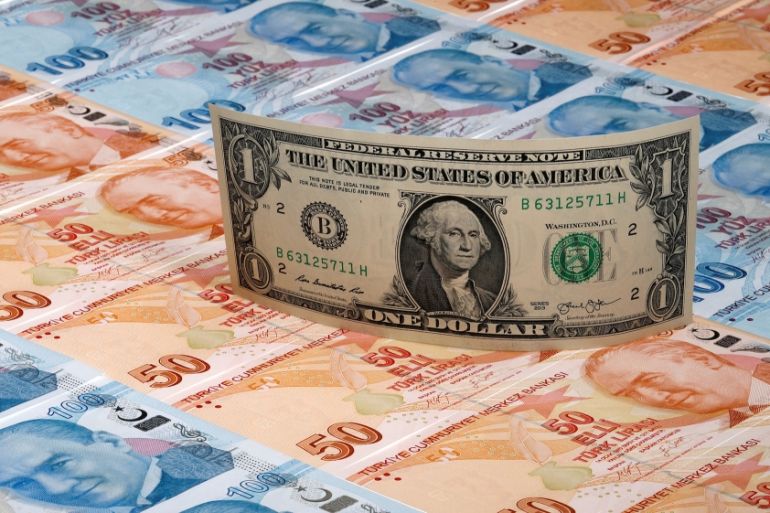How could Turkey overcome its currency woes?
Turkey would not need to impose capital controls to stem the plunge in the lira, writes Erkin Sahinoz.

Not long ago it would have been deemed inconceivable to see Turkey, a long-standing US ally and staunch member of NATO, in the list of countries that US has been targeting and threatening with strong economic and political sanctions.
Ties between Washington and Ankara have been strained for a while over many critical issues such as differences on Syria policy, a Turkish banker’s conviction in the US, S-400 missile defence system deal, halt in delivery of F-35 military jets to Turkey and Washington’s reluctance to extradite Gulenist Terror Group (FETÖ) leader Fethullah Gulen.
Keep reading
list of 4 itemsIndia’s income inequality widens, should wealth be redistributed?
Biden slaps new tariffs on Chinese imports, ratcheting trade war
One of the biggest hurdles for athletes on the Olympic path: Money
Similarly, the case of Pastor Andrew Brunson, jailed in Turkey on terrorism charges, has been burning like a slow fuse for nearly two years, flared up in recent weeks with the US threatening Turkey with large sanctions unless he is released immediately.
It is quite clear that evangelical pastor has turned into a top issue in Turkey-US relations because white evangelicals played a crucial role in the election of Trump in 2016. And now Trump seems quite decisive in taking actions that are likely to consolidate his core power base as he approaches midterm elections that will take place in November. Unfortunately, by wreaking havoc with the Turkish economy and its financial markets, the Trump Administration has brought the bilateral relationship between the two countries into a protracted and hard-to-solve crisis.
News of sanctions further scared financial markets with the Turkish lira slumping to a record low against the US dollar yesterday. At one stage on Monday morning one dollar bought 7,2 liras. After the recent meltdown, lira has become the world’s worst performing currency in 2018, overtaking crisis-hit Argentina’s peso. The Turkish economy, already in a fragile state even before the sanctions, has undoubtedly been hit by the currency rout.
Despite internal and external adverse shocks, the Turkish economy has grown very fast and consideably above its potential rate over the past two years. This outstanding growth performance has been mainly driven by policy stimulus and a well-diversified business sector. However, current account imbalance, a well-known side effect, arising from excessive reliance on domestic demand and external savings, amplified foreign financing needs. As a result, risk premium rose markedly, increasing Turkey’s vulnerability to external shocks.
The Turkish lira has recovered some of its losses yesterday, but the plunge in the currency over the past few weeks is now on a scale which has, in the past, not only prompted the Central Bank to rise interest rates aggressively, but also sharply deteriorated business and consumer sentiment.
Central Bank of the Republic of Turkey (CBRT) implemented a mild policy response yesterday. The CBRT took measures such as ROM adjustments and Reserve Requirement Ratio reductions. These were definitely necessary actions for the banking system as far as effective functioning of financial markets and banks’ liquidity management are concerned.
By deciding not to open one week repo channel for funding, the CBRT also delivered an indirect rate increase of 1.50-3.00 percent. Banks will have to borrow either at the overnight lending rate of 19.25 percent or at the late liquidity window lending rate of 20.75 percent or both. Therefore, de facto tightening amount is not known at the moment. Lira’s response to these measures unfortunately remained moderate.
The secondary market benchmarket rate, currently at 25.83 percent, continues to remain well above the CBRT’s de facto policy rate. The ongoing increase in the risk premium and the decrease in portfolio inflows affects the value and the implied volatility of the Turkish lira. 1-month implied volatility hovers around 60.0 percent, indicating highly challenging business and financial conditions for decision-makers in the ecosystem.
There is a lot of uncertainty about how things will develop. Therefore, tweaking reserve option mechanism and implementing minor tools (compared to decline in risk appetite) may not be sufficient to help stabilise the lira. Essentially, the history may repeat itself and the CBRT could be forced by the market to raise rates at an emergency sitting in the coming weeks, depending on the pace of lira’s depreciation.
As Turkey has been experiencing its worst currency crisis since 2001, net fx position of non-financial companies, which stood at $217.3 bn as of May of 2018, remains as a key concern not only for holders but also for lenders. In our view, even if the political standoff between Turkey and the US gets somehow resolved, the lira would only partially recover as the previous currency shock episodes suggest.
Tightening monetary policy at the time when the economic slowdown is under way would be an unpopular decision. Nonetheless, among the options, the most market friendly alternative seems to be raising interest rates until the lira becomes sufficiently stable to restore confidence among investors. If accompanied by economic reforms to reduce Turkey’s vulnerabilities and a tighter fiscal policy, Turkish economy can overcome highly difficult operating conditions more quickly. Turkey would never implement capital control measures as it has all the necessary tools to implement a large-scale intervention to sustain a healthy economy.
The views expressed in this article are the author’s own and do not necessarily reflect Al Jazeera’s editorial stance.
